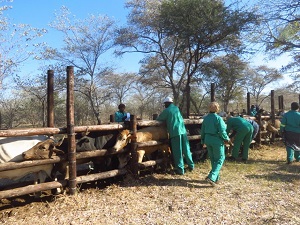
SWAKARA Industry Forum provides feedback to producers

The top ten Swakara producers were honoured last week by the Karakul Board of Namibia at the annual Swakara Industry Forum in Keetmanshoop.
The forum was officiated by Raimar von Hase, Chairperson of the Karakul Board. In his opening remarks, he explained the current situation in the fur industry as he said; “the worldwide fur industry is currently going through deep waters. The very optimistic picture of the last three years is suddenly bleak and very dark clouds cast shadows over the immediate future.” He added, “This was attributed by the warm winters in Russia and China, the biggest buyers of fur; the saturated market; the drop in mink prices and the uncertainty of the Russia/Ukraine political situation spreading across, especially in Europe.” The overall fur price drop also affected Swakara prices, because the Swakara price structure is pegged to that of mink.
On Wednesday morning, 24 September, an elite ram auction took place at Canyon Hotel. Danie Visser Trust paid the highest price of N$60,000 for the white Swakara ram (from Mr Dirk J Louw) at the auction; and the highest price for the black Swakara ram (from Karsten Boerdery) of N$40,000 was paid by Mr Jan Wasserfall.
The forum was attended by two international guests; Mike Moser, Director of Standards, Welfare and Science from the International Fur Federation (IFF) and Ditte Sorknaes, Marketing Manager at Kopenhagen Fur. Mr Moser informed the producers on the importance of fur internationally and the strict code of conduct the fur industry operates under. “Many communities depend almost entirely on the fur trade, for instance in Kastoria, Greece where 80% of the population is employed by the fur trade. In Russia, Canada, USA, Finland, Norway, Poland and Namibia, the fur trade helps to support indigenous and rural communities in remote areas. The IFF is also running campaigns under #FurNow to entice people to feel proud when using fur.” The International Fur Federation (IFF) is an independent and neutral federation of national associations and organisations representing all fur sector interests worldwide.
Ms Sorknaes gave a presentation on the price developments in the fur industry and focusing on Swakara. “There has been a decrease of prices in fur from September 2013, due to the Russia-Ukraine conflict; conflict with Chinese customs; saturated market, surplus supply of fur and shift in fashion,” she explained.














































